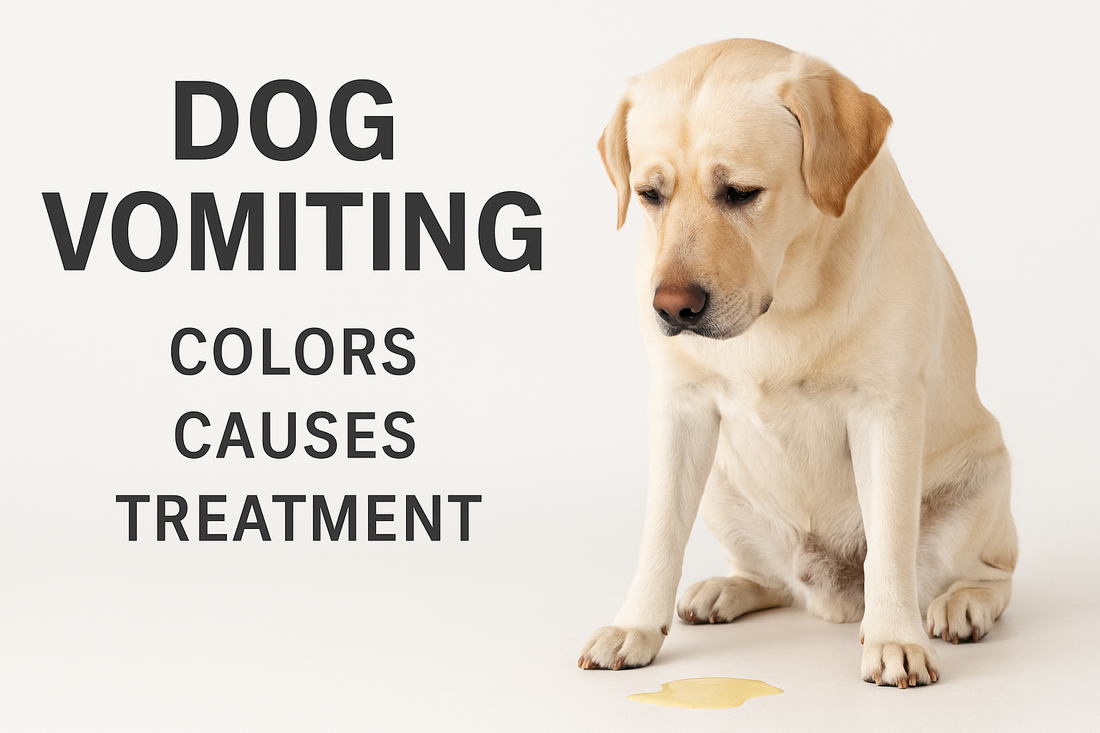
🐶 Dog Vomiting – Vital Guide to Colors, Causes, and Quick Action Steps
Dog Vomiting – Vital Guide to Colors, Causes, and Quick Action Steps
Is It Normal for Dogs to Vomit?
Occasional vomiting in dogs can be relatively common and not always a cause for concern.
It can occur due to an empty stomach, eating too fast, or minor digestive issues.
However, frequent vomiting or vomit with certain colors may indicate a more serious health problem.
It’s important to observe the color, frequency, and accompanying symptoms carefully and take action promptly if needed.
Dog Vomit Color Guide – What It Means (Focus Keyword)
1. Yellow Vomit
-
Cause: Bile from an empty stomach
-
Possible Conditions: Bilious vomiting syndrome, bile reflux gastritis
2. White Foam Vomit
-
Cause: Air or stomach acid
-
Possible Conditions: Esophagitis, mild gastritis
3. Green Vomit
-
Cause: Grass ingestion or bile
-
Possible Conditions: Gastroenteritis, pancreatitis, poisoning
4. Brown or Coffee-Colored Vomit
-
Cause: Digested blood
-
Possible Conditions: Stomach ulcers, hemorrhagic gastritis
5. Red or Blood-Tinged Vomit
-
Cause: Active bleeding from the mouth, esophagus, or stomach
-
Possible Conditions: Severe ulcers, poisoning, injury from foreign objects
Common Causes of Vomiting in Dogs
-
Overeating or eating too quickly
-
Ingestion of foreign objects (e.g., toy pieces, bones)
-
Food poisoning or toxic substances
-
Parasitic infections (roundworms, tapeworms)
-
Viral diseases (e.g., parvovirus)
-
Liver or kidney dysfunction
-
Stress (moving, changes in environment)
What to Do When Your Dog Vomits
1. If it’s a one-time mild episode:
-
Withhold food for 6–12 hours, then offer a small amount of bland food
-
Keep fresh water available at all times
2. If vomiting is frequent or accompanied by symptoms:
-
Visit the veterinarian immediately
-
Take a photo of the vomit and note color, amount, and frequency to help with diagnosis
3. What NOT to do:
-
Do not give human medications
-
Do not force food or water into your dog’s mouth
How to Prevent Vomiting in Dogs
-
Use slow-feeder bowls to reduce eating speed
-
Keep floors clean and prevent access to non-food items
-
Secure trash cans and avoid table scraps
-
Maintain regular deworming and vaccinations
-
Minimize stress and sudden environmental changes
🛒 Recommended Products for Vomiting-Prone Dogs
-
Vet-approved bland diets for sensitive digestion
-
Slow-feed bowls
-
Digestive support supplements
👉 Explore Dog Digestive Health Products
External Resource (DoFollow)
Read more on AKC – Dog Vomiting Causes and Treatment
Internal Resource
👉 Related article: Healthy Dog Diet Essentials
🧩 Frequently Asked Questions (FAQ)
Q1. Is it okay if my dog vomits once a day?
A1. Occasional, isolated vomiting may not be serious.
However, if it repeats or is accompanied by other symptoms, consult a veterinarian immediately.
Q2. What should I feed my dog after vomiting?
A2. Small portions of bland foods like boiled chicken or rice can help.
But always consult a vet before changing your dog’s diet if vomiting persists.
Q3. My dog vomited white foam. Should I be worried?
A3. One or two episodes of white foam without other symptoms may not be serious.
If vomiting continues or is paired with lethargy, diarrhea, or appetite loss, see a vet right away.
🥣 What to Do After Your Dog Vomits – Recovery and Feeding Tips
After a vomiting episode, it’s important to give your dog’s digestive system time to recover and avoid further irritation.
✅ Immediate Aftercare Steps:
-
Withhold food for 6 to 12 hours: Give the stomach time to rest.
-
Provide small amounts of water frequently: Don’t allow your dog to gulp large amounts at once.
-
Monitor for symptoms: If vomiting resumes or your dog appears lethargic, see a vet immediately.
-
Keep the environment calm: Stress can worsen nausea.
🍲 Recommended Foods After Vomiting
Once your dog has rested for several hours and has kept water down, you can offer small portions of bland food to test tolerance.
Top recommended bland foods:
-
Boiled chicken (no skin, no seasoning)
-
Plain white rice
-
Boiled sweet potatoes (mashed)
-
Low-fat cottage cheese
-
Canned pumpkin (100% pure, no added sugar)
-
Prescription gastrointestinal dog food (as advised by your vet)
Start with a tablespoon or two and observe.
If no vomiting occurs after a few hours, gradually increase the portion over the next 1–2 days before resuming regular feeding.
⚠️ Foods and Practices to Avoid
-
No fatty foods (e.g., cheese, processed meats)
-
Avoid table scraps and human treats
-
Don’t offer bones or chews until digestion stabilizes
-
No flavored broths unless salt-free and vet-approved
💡 When to Call the Vet
Even after feeding bland food, contact your vet immediately if:
-
Vomiting returns
-
There's blood in the vomit
-
Your dog refuses to eat for more than 24 hours
-
Your dog shows signs of dehydration or weakness

